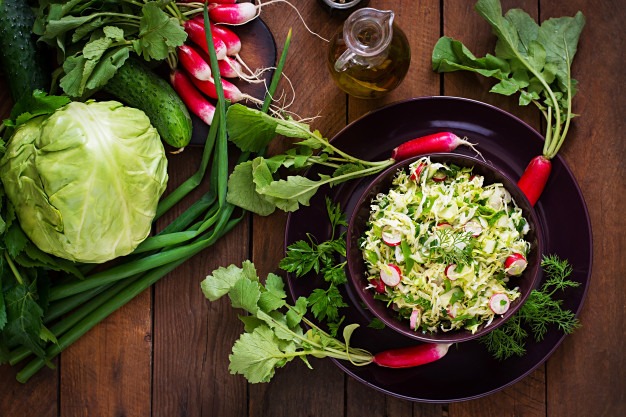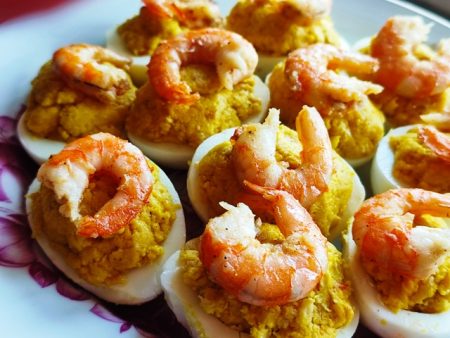This wonderful fresh vitamin salad will brighten up any festive or everyday table. At first glance, this is a common cut of fresh vegetables and herbs. But if you add a spicy sauce here, the salad will be enriched with new flavors. This salad will appeal to vegetarians and people who prefer light meals in their diet.
Directions
0/0 steps made- Take the vegetables and herbs you like. In our case, it is fresh cucumber, radish, cabbage, as well as onion leaves, parsley, and dill. Cut everything as you like.
- Let’s prepare the dressing sauce for the salad. Squeeze lemon into a small bowl, add olive oil, mustard sauce. Also, squeeze garlic here. Add some salt and mix well.
- Combine vegetables, herbs, and dressing and mix well again.
The Best way to squeeze a lime or lemon (for vitamin salad recipe).
Video by Gavin Wren
The recipe features a variety of fresh vegetables, including lettuce, cucumber, and bell pepper, as well as fresh herbs such as dill and parsley.
In terms of nutritional value, the salad contains a range of vitamins and minerals, including vitamins A, C, and K, as well as folate, potassium, and magnesium. The addition of nuts and seeds also provides healthy fats and protein to the dish.
It’s difficult to pinpoint the exact cuisine that this recipe belongs to, as it includes a mix of ingredients commonly used in various cuisines.
However, the use of fresh herbs like dill and parsley, as well as the inclusion of walnuts and pumpkin seeds, are common in Eastern European cuisine. The use of a vinegar-based dressing is also reminiscent of many Western salad dressings.
That being said, this recipe could be considered a fusion or modern interpretation of various culinary influences, rather than belonging to a specific cuisine.
Pros, Cons and History for this salad recipe:
Pros:
- Nutritious: The salad contains a variety of fresh vegetables and herbs that are packed with vitamins and minerals, making it a healthy choice.
- Flavorful: The combination of fresh herbs, vegetables, and nuts/seeds provides a range of flavors and textures, making it a tasty and satisfying dish.
- Easy to prepare: The recipe is relatively simple and straightforward, making it accessible to home cooks of all levels.
- Versatile: The salad can be served as a side dish or a main meal, and can be adapted to suit different dietary preferences and restrictions.
Cons:
- Time-consuming: Preparing all the vegetables and herbs for the salad can be time-consuming, especially if you don’t have a lot of experience with food preparation.
- Requires fresh ingredients: The recipe calls for a variety of fresh vegetables and herbs, which may not always be available or affordable, depending on where you live.
- May not be filling enough on its own: While the salad is nutritious and flavorful, it may not be filling enough on its own for some people, and may need to be supplemented with additional protein or carbohydrates.
History:
- It appears to be a modern creation by the website Proborsch. However, salads in general have a long history, with ancient Greeks and Romans consuming mixed greens and vegetables dressed with oil and vinegar as early as the 4th century BCE.
- Throughout history, salads have evolved and adapted to reflect regional cuisines and available ingredients. For example, in the Middle Ages, salads were often made with fruits and sweet dressings, while during the Renaissance, salads in Europe began to incorporate more savory ingredients like meats and cheese.
- Today, salads continue to be popular around the world, with endless variations and creative interpretations. The focus on fresh, healthy ingredients and colorful presentation make salads a staple in many cuisines, from simple green salads to more complex creations like the one featured in this recipe.
Additional Info About This Recipe:
- Cultural or regional significance:
As mentioned earlier, the recipe doesn’t seem to have a specific cultural or regional significance. However, some of the ingredients like fresh herbs and walnuts are commonly used in Eastern European cuisine. It’s also worth noting that salads featuring fresh vegetables and herbs are popular in many cultures around the world. - Recipe origin:
It’s unclear who developed this specific recipe, as it appears to have been created by the website Proborsch. However, it’s possible that the recipe was inspired by traditional salads or culinary influences from various regions. - Health benefits of the ingredients:
Lettuce is a good source of vitamin A and K, cucumbers are high in water content and can help with hydration, bell peppers are rich in antioxidants and vitamin C, and fresh herbs like dill and parsley can provide anti-inflammatory and digestive benefits. Additionally, pumpkin seeds and walnuts are good sources of healthy fats and protein. - Vitamins and minerals in each vegetable or herb:
Lettuce is rich in vitamins A and K, as well as folate and iron. Cucumbers are high in water content and provide small amounts of vitamins C and K, as well as potassium and magnesium. Bell peppers are a good source of vitamin C, as well as vitamin A and potassium. Fresh herbs like dill and parsley are low in calories and provide small amounts of vitamins A and C, as well as minerals like calcium and iron. - Substitutions for nuts or seeds:
Other types of nuts or seeds that could be used in the recipe include almonds, pecans, or sunflower seeds. Readers could experiment with different types of nuts or seeds to find the flavor and texture they prefer. - Adaptations for vegan or gluten-free diets:
The recipe is already vegetarian, but it could be adapted for a vegan diet by omitting the honey in the dressing and using a vegan-friendly vinegar. To make the recipe gluten-free, readers could ensure that all ingredients, including the vinegar, are certified gluten-free. - Incorporating the recipe into a meal plan:
Readers could use this recipe as a side dish for a larger meal, or add protein like grilled chicken or tofu to make it a complete meal. It could also be used as a topping for a grain bowl or added to a wrap for a quick lunch. - Serving suggestions:
Other dishes that could be served alongside the salad include grilled fish or shrimp, roasted vegetables, or a soup or stew. Dressings that would pair well with the flavors in the salad include balsamic vinaigrette or a lemon-herb dressing.
This recipe seems like a great option for a healthy and refreshing meal or side dish. Just be sure to follow any specific instructions or ingredient measurements carefully to achieve the best results.





Recent comments